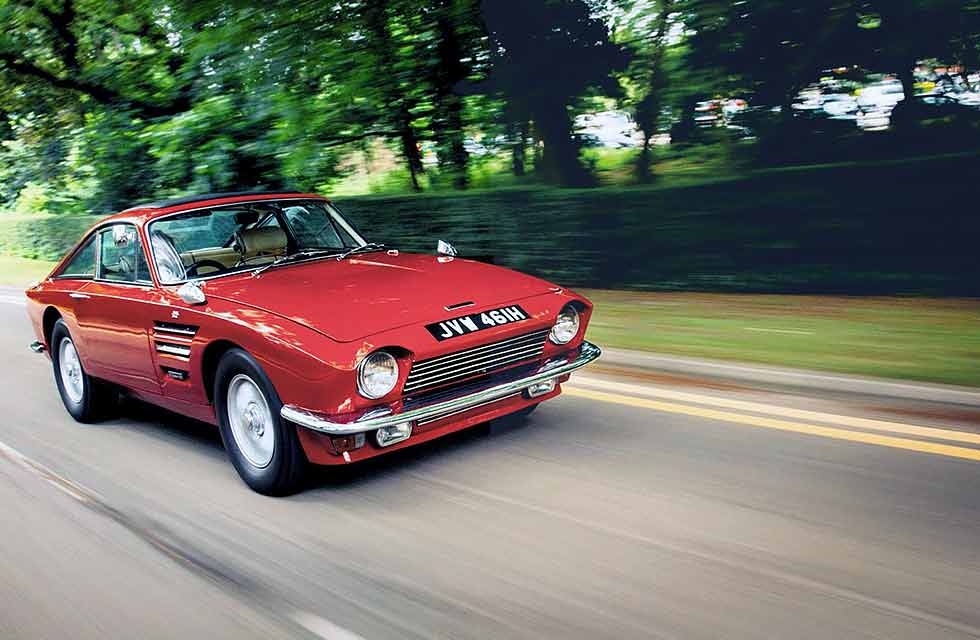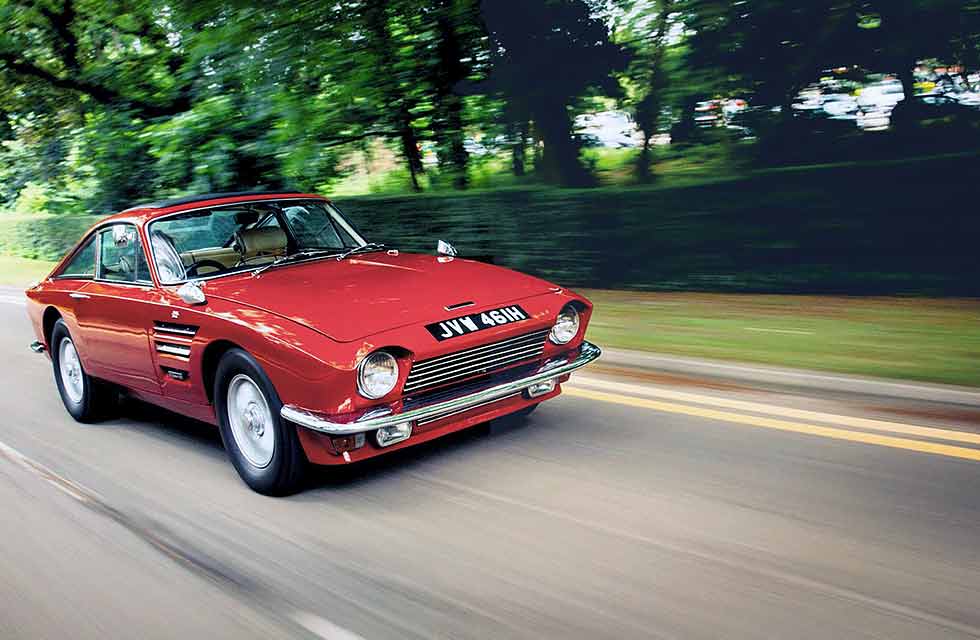
The Trident Clipper’s recipe of 271bhp V8, two-plus-two seating and featherweight 1000kg construction occupied a niche of one. We drive a survivor to find out if it made sense. Words Ivan Ostroff. Photography Glenn Lindberg.
A Fair Old Clip Braving the V8 Trident Clipper: luxury sports car or brutal GT?
As I prepare to drive this brutal British 2+2 GT, I can feel the hairs on the back of my neck standing up. This is a car that has little time for fainthearted drivers. As I pull the glassfibre door to, I’m surprised by its well-built, good-it clonk given its kit-carlike nature. Once strapped into the well-upholstered magnolia hide driving seat I note the steering wheel is angled slightly left of centre, while the pedals are offset to the right. It’s all a bit Triumph Herald-like in here but on the plus side, there is plenty of space to rest your left foot when it’s not on the clutch. The interior exudes a feeling of quality, partly derived from the woodwork. It is functional in here, cosy and very British.

The tachometer reads to 8000rpm; perhaps that’s optimistic with an unbalanced pushrod Ford V8, but the speedo that reads to 160mph certainly means it. A previous owner supposedly hit 160mph on the Basingstoke bypass, and clocked 155mph at the Brighton seafront trials in 1970. Thankfully the controls are clear to see and operate, but familiarising myself with them is difficult – there are switches and warning lights all over the place.
However, the thing that really counts is the Windsor V8 that the Clipper has nestling under its bonnet. I twist the key, the starter motor churns slowly, almost resentfully, and just when I think it is turning too slowly to catch, the 4.7-litre Ford HiPo V8 rumbles into life. I don’t have to concern myself with the fussy idiosyncrasies associated with a high-revving Italian multi-cam V12 screamer. No need to sit there warming everything up, this is pure thumping grunt – just blip the throttle and listen to the music.
I slip the lever of the Ford Toploader four-speed manual easily into first gear and the Clipper rumbles forward. The clutch is on the heavy side but not unusually so for the era. I’ve adjusted the rake of the seat to allow for an easy reach to the steering wheel and the crooked driving position is comfortable enough.
Out on the open road there are two ways to drive this car – I can relax and leave the car in top gear and enjoy the flexibility, or make use of the power to get a proper move on; each method is enjoyable in its own way. Taking the first option, the Clipper seems unfazed by slow town traffic, the HiPo remaining smooth and showing no tendency to overheat. You can lope along lazily in third gear, unless you actually have to stop. If you are feeling particularly lazy, just start in second and then go directly into top – there’s so much torque you can almost treat it like an automatic. But if you go for the second option you need to take special care, because the Trident will give a clip around the ear to anyone not showing it due respect. After all, this was one of the fastest 2+2 coupés in the world when new. Under that Italianate glassfibre bodywork – a development of the convertible that Trevor ‘Fiore’ Frost supposedly sketched for TVR executives in a Lancashire pub in 1963 – is the 289ci lump from an AC Cobra. It will hit 60mph in 4.4sec and cover a standing quarter mile in 13.9sec.
On a wet road, the tall 205-section tyres have an impossible fight on the hands, with the back end breaking away quickly under power. In the dry though, I try to balance the revs with the grip available from the Avon-shod Minilites and I’m rewarded with traction and manageable wheelspin. With 3000rpm on the rev counter, I drop the clutch and the Clipper catapults away. The T10 gearbox is not quick but once used to it, changes are quite slick. Just north of 60mph, I grab second and floor it again. The V8 growls triumphantly, the tachometer needle climbs through 5000rpm and I’m pinned into my seat. The exhaust is howling a dark, full-throated scream and the wheels are still spinning when I move across the gate and listen to the metallic clap to third. The Clipper’s acceleration is amazing and even when the car’s road speed reaches unmentionable levels, in a straight line in the dry at least, it is totally predictable if not without drama.
After buying the car, owner Steve Riley found it went round left-hand corners better than right-handers. On further examination, he found the rear axle was twisted. Apparently, an earlier owner believed that the body was moving around on the chassis. In fact the suspension had come away from the chassis and when Steve rebuilt it, he found one torsion bar was a quarter-inch shorter than the other. Once he dealt with that the problem disappeared.
Today, there is a fair amount of roll when cornering but a fast entry in the dry is reasonably predictable. The Clipper wants to understeer initially and then as I apply some throttle, the tail comes out under power. Into a long left-hander, I can feel the Avons up front are still gripping as the rear end begins to slip away. I squeeze the right pedal more, the tyres squeal loudly in objection. I sense that the front end is about to let go, so I instinctively wind on more lock while feathering the throttle. I leave the corner with understeer countered, rear end caught and car balanced nicely. I turn in early for the next corner and get on the throttle while at the same time twirling away at the worm and peg steering. At no point can I let my attention wander.
At and beyond the limit, it becomes clear that the Clipper’s drivetrain overwhelms its humble Austin-Healey 3000 underpinnings. The stillborn TVR Trident it was derived from employed Blackpool’s Grantura chassis; when the model rights were taken on by TVR dealer and Trident marque founder Bill Last, the chassis rights were not included. With Trevor Fiore’s design first restyled in a narrower form to it its ’Healey underpinnings, and then changed from the steel of the convertible prototype to glassfibre 2+2 coupé for production, it seems the chassis received minimal uprating to withstand the demands of its new engine, retaining its live-axle rear suspension.
Later Tridents did attempt to address these shortcomings, using the same basic body design with different chassis and drivetrains. From 1969, the Venturer put a 3.0-litre Ford Essex V6 on a TR6 chassis with a lengthened wheelbase and all-round independent suspension; it was replaced in 1971 by the £2584 Tycoon, which used 2.5-litre Triumph straight-six with an automatic gearbox and Lucas fuel injection. Ultimately most Tridents were of the V8 variety, but that put the company in a weak position for the Seventies Oil Crisis. The company was shuttered in 1976, but before the party ended for good in 1978 there were a few final cars built with a 5.6-litre Chrysler V8 – one of which was Bill Last’s personal car. It now lives in the Ipswich Transport Museum.
Fast-forward 40 years and I hardly feel like this 4.7-litre car is lacking in cubic capacity or power. After a while I’m totally at ease with the offset pedal positions and have no difficulty in heel-and- toe downchanges, which helps with that slow T10 gearbox.
The front disc, rear drum set up works well and is adequate for normal road use. While the suspension thuds a bit at the rear when going over bumps, the general ride quality is good. That worm and peg steering box feels heavy though, and does tend to be tiring after a while. Of course with so much power and torque under your right foot, this car’s main drawback has to be the fuel economy – 18mpg on a run and around 12mpg around town is going to hurt your pocket in 2018. On the other hand, if that’s a cause for concern you’re probably sitting in the wrong sort of car.
For the young family man this car would have made good sense, at least pre-Oil Crisis. Considering rival four-seater GTs of the time, the Jensen CV8 was able to carry four on board but by 1966 it was at the end of its production run. The Maserati Sebring was another genuine four-seater GT but it cost well in excess of £5000 and its performance figure of 0-60 in 8.5 seconds and top speed of 137mph were not in the Clipper’s league. Then there was the Aston Martin DB6 but that took 8.4 seconds to reach 60mph had a top speed of 145mph and most importantly cost around £4000.
When current owner Steve was a 17-year-old apprentice, his boss’s son Robert Halliwell pulled up in this very Clipper outside the factory. ‘I was all over it like a rash,’ recalls Steve. ‘I thought it was the most wonderful car I had ever clapped eyes on. I worked for that company for 29 years and over the years I got to know the owner very well. When he retired in 1998, I asked him what happened to his son’s Trident. He said it was parked up in his garage, wasting away. He wanted £3000 for it and at that time I was going through a divorce and it was more than I could afford. Eventually, he sold the car to his sister-in-law. It just so happened that I was a friend of her dad, and one night in 2001 we were sitting at his place having a scotch together when I spotted the Trident under a tarpaulin in his garden. It was in a real mess but his daughter agreed to sell it to me.’
Even in its recommissioned state the Clipper is by no means perfect, but I can certainly understand the attraction. Despite being relatively affordable by both period and contemporary standards – if you can find one – it’s one of those special cars that you have to look square in the eye and say, ‘It’s either you or me that’s going to be in control today, and I’m telling you it’s going to be me.’ And you have to mean it.
TECHNICAL DATA FILE SPECIFICATIONS 1969 Trident Clipper
Engine 4727cc (289ci) ohv V8, Holley four-barrel carburretor
Max Power 271bhp @ 6000rpm / DIN
Max Torque 312lb ft @ 4000rpm / DIN
Transmission Four-speed manual, rear-wheel drive
Steering Worm and peg
Suspension Front: coil springs, lever-arm dampers, anti-roll bar. Rear: live axle, leaf springs, lever-arm dampers
Brakes Discs front, drums rear
Weight approximately 1000kg
Performance 0-60mph: 4.4sec; top speed: 160mph (subject to gearing)
Price New £1925 in 1967
Classic Cars Price Guide £12,500-£35,000
‘The wheels are still spinning when I move across the gate into third’
It’s comfy and raucous in here. No shortage of instrumentation to monitor. HiPo V8 made the 1000kg Clipper one of the fastest 2+2s of its day. The Clipper’s rear lights were lifted from a Leyland Landcrab; owner Steve has added a second set of modules to improve the looks. Before current owner Steve finally snared this Clipper, it had eluded him for his entire adult life The worm and peg steering is rudimentary but doesn’t blunt the thrill of the drive.
‘We were sitting having a scotch together when I spotted the Trident under a tarpaulin in his garden’
RESTORING AND RUNNING A TRIDENT CLIPPER
Says owner Steve Riley, ‘After buying it in 2001 for £2000, I trailered it home. It was in a really bad way – the engine was seized, the tyres were rotten, even the wheels were rotten. I took the engine out and after a fortnight soaking it in WD-40 it slowly began to turn, so then I stripped it. I removed the body and proceeded to rebuild whatever needed it – the brakes and the suspension were totally rebuilt, but the gearbox and back axle seemed fine – although I later found the axle was bent. I had it back up and running in about a year. A while later I had the interior re-trimmed and the wood refurbished – that was all completed by 2010.
‘The Clipper is fairly straightforward to maintain; I do everything myself. The only real difference from a standard Austin-Healey chassis is that at the rear there are outriggers to hold the anti-tramp bars. You have to watch the steering system, because it develops play. You can adjust it to a certain extent until replacement becomes a necessity, but the part is readily available just like the other Austin-Healey spares that are required.
‘The Clipper is the sort of car that I always dreamed about and wanted to own; a small car with a big engine. Being based on an Austin-Healey, with a stock Ford 289cu engine, it is simple to keep and cheap to maintain. I just love the car; I’ll never part with it.’






